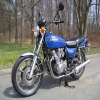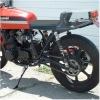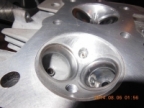Old School Tuning
- TwoCam
-
 Topic Author
Topic Author
- Offline
- User
-

Registered
- Posts: 133
- Thanks: 57
Old School Tuning
08 Jul 2017 07:13
Found this interesting tuning method..... quite simple. Far from scientific. But it could be helpful I guess. I'm going to try it on my bike along with a 4 gas meter on an old scope I have at the shop. Some day I'll invest in an AFR meter, to actually see what's going on while riding.
The following user(s) said Thank You: GPz550D1
Please Log in or Create an account to join the conversation.
- 650ed
-

- Offline
- User
-

Registered
- Posts: 15337
- Thanks: 2833
Re: Old School Tuning
08 Jul 2017 08:33
Keep in mind that a "lean" condition is not necessarily a carb adjustment problem. It can be caused by leaking carb holders, wrong or lack of an air filter, etc. If a bike has been running well and then exhibits a lean condition those types of issues are more likely than an issue that requires re-jetting or other carb adjustments. Another factor is that the carbs may be dirty and just need a cleaning, especially if the bike sat without being run for more than a few weeks. Ed
1977 KZ650-C1 Original Owner - Stock (with additional invisible FIAMM horn)
The following user(s) said Thank You: TwoCam
Please Log in or Create an account to join the conversation.
- loudhvx
-

- Offline
- KZr Legend
-

Registered
- Posts: 10863
- Thanks: 1622
Re: Old School Tuning
08 Jul 2017 10:02 - 08 Jul 2017 10:13
That sounds like non-sense to me. When you blip the throttle, other parts of the jetting will affect what happens, thus defeating the purpose of isolating the idle setting.
By using the "lean-drop" method (standard method used for decades) to get the highest idle for a particular position on the idle screw, you will be in the power range of the AFR. That's where you want to be.
It's very simple.
You get a very precise, external, electronic tachometer and adjust the mixture. The bike's tach is usually not precise enough to do it correctly. You turn the mixture lean until the RPM starts to drop, then turn it back just barely enough to restore the highest RPM achieved. (You don't go rich until the RPM drops because then fuel may accumulate in the intake tract, and while it is evaporating out, the idle will not be at its equilibrium.)
If the idle gets too high, then reset it to where it should be, then start over.
You do this for each carb, and if everything is good, the screws will end up within 1/4 or 1/2 turn of each other (ideally all the same). Even with a wideband, this method should be done at least once since it will identify if one carb is running differently from the others (indicating a problem).
That gives you a baseline setting for being at about 12.5 ish AFR. Temperature will affect setting, so if it's a really hot day, you will want to then turn the mixtures very slightly richer, so on cool days it will be close to correct. If it's a cold day, then vice versa. Write down what the baseline setting was, and note the temperature.
Obviously, if all the carbs are running exactly the same, and you have a wideband, then you can just set the mixture accordingly with a wideband. But again, on a hot day you will want to set it in the 11.5 to 12, range, and on a cold day 12.5 to 13 range. When the temperature changes to an average day, like 70 degF, the AFR will get near 12.5.
Sometimes, you will get an idle that climbs with temperature too much. For those cases, I will set the AFR slightly richer.
BTW, this is all basically the very last step of jetting. This and syncing might get done at the same time as they both affect each other. You will do it at any intermediate jetting step, but when all is said and done, this will be the final step. If any other parts of the jetting gets messed up because of it, then you need to correct the jetting accordingly and revisit this final step.
By using the "lean-drop" method (standard method used for decades) to get the highest idle for a particular position on the idle screw, you will be in the power range of the AFR. That's where you want to be.
It's very simple.
You get a very precise, external, electronic tachometer and adjust the mixture. The bike's tach is usually not precise enough to do it correctly. You turn the mixture lean until the RPM starts to drop, then turn it back just barely enough to restore the highest RPM achieved. (You don't go rich until the RPM drops because then fuel may accumulate in the intake tract, and while it is evaporating out, the idle will not be at its equilibrium.)
If the idle gets too high, then reset it to where it should be, then start over.
You do this for each carb, and if everything is good, the screws will end up within 1/4 or 1/2 turn of each other (ideally all the same). Even with a wideband, this method should be done at least once since it will identify if one carb is running differently from the others (indicating a problem).
That gives you a baseline setting for being at about 12.5 ish AFR. Temperature will affect setting, so if it's a really hot day, you will want to then turn the mixtures very slightly richer, so on cool days it will be close to correct. If it's a cold day, then vice versa. Write down what the baseline setting was, and note the temperature.
Obviously, if all the carbs are running exactly the same, and you have a wideband, then you can just set the mixture accordingly with a wideband. But again, on a hot day you will want to set it in the 11.5 to 12, range, and on a cold day 12.5 to 13 range. When the temperature changes to an average day, like 70 degF, the AFR will get near 12.5.
Sometimes, you will get an idle that climbs with temperature too much. For those cases, I will set the AFR slightly richer.
BTW, this is all basically the very last step of jetting. This and syncing might get done at the same time as they both affect each other. You will do it at any intermediate jetting step, but when all is said and done, this will be the final step. If any other parts of the jetting gets messed up because of it, then you need to correct the jetting accordingly and revisit this final step.
1981 KZ550 D1 gpz.
Kz550 valve train warning.
Other links.
Kz550 valve train warning.
Other links.
Last edit: 08 Jul 2017 10:13 by loudhvx.
The following user(s) said Thank You: TwoCam, Kray-Z
Please Log in or Create an account to join the conversation.
- TwoCam
-
 Topic Author
Topic Author
- Offline
- User
-

Registered
- Posts: 133
- Thanks: 57
Re: Old School Tuning
08 Jul 2017 10:47
Totally agree with the comments.... just found this technique interesting. That way people did things years ago with little to no technical help. Don Garlits pioneered the use of Nitro...... blew up a lot of engines dialing the proper ratio of it to fuel before getting it right...... some of the best tips I have learned were from the old school guys..... back when off the shelf GO-FAST parts didn't exist. On that note if any of you have never seen the movie, Fastes Indian in the World. Would recommend checking it out. Great true story of an old man that set the fastes land record on the salt flats. Everything he did himself. I have it somewhere... see if I can find it and get a pic.
Please Log in or Create an account to join the conversation.
- Kray-Z
-

- Offline
- User
-

Registered
- I need more power Scotty....
- Posts: 583
- Thanks: 107
Re: Old School Tuning
08 Jul 2017 12:38
BTW - for anyone looking to buy a precise / accurate electronic tachometer for tuning, you can kill two birds with one pricey stone if you care to. High end inductive timing lights can be purchased that have some pretty handy features, like a precision tach (for our wasted spark ignition engines, they usually read out double actual RPM, though. Some have a 2 stroke setting that will fix this slight problem), and settable on the fly timing advance or retard in degrees of crank rotation (so you can check your advance curve at various RPM), I had a Snap-On one until someone brazenly just walked in while we were at lunch break and stole it from our old shop, but I replaced it with a cheaper brand that cost half as much and worked just as well. Unfortunately, I'm now borrowing my neighbors' basic timing light - yep, you guessed it - someone stole my second one, too....
-Scott
-Scott
2-04 R1, 81 CSR1000, 81 LTD1000, 2-83 GPz1100, 3-79CBX, 81 CBX, 3-XS650, 84 Venture, +parts
Quote "speed costs money...how fast do you want to go?" (Which Z movie?)
Universal formula for how many motorcycles one should own = n + 1, where n is how many motorcycles you own right now....
Quote "speed costs money...how fast do you want to go?" (Which Z movie?)
Universal formula for how many motorcycles one should own = n + 1, where n is how many motorcycles you own right now....
Please Log in or Create an account to join the conversation.
Moderators: Street Fighter LTD
